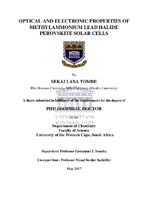| dc.description.abstract | Organic-inorganic hybrid perovskite solar cells have emerged as promising materials for next-generation
photovoltaics with certified efficiency of 22.1%. Despite rapid developments, achieving precise control
over the morphologies of the perovskite films, enhanced stability and reproducibility of the devices remains
challenging. In this work, we employed a low-temperature solution processing technique to attain high
efficiency inverted planar heterojunction devices with device architecture
ITO/PEDOT:PSS/Perovskite/PCBM/Al (indium doped tin oxide; poly(3,4-ethylenedioxythiophene)
polystyrene sulfonate; [6,6]-phenyl-C61-butyric acid methyl ester; aluminium). A perovskite solar cell
fabrication technique is developed and opto-electronic characterization of solution-processed planar
heterojunction perovskite solar cells based on methylammonium (MA) lead halide derivatives, MAPbI3-xYx
(Y = Cl, Br, I) is presented in this thesis work. By employing lead iodide (PbI2) with various amounts of
additional methylammonium halides, perovskite precursor solutions were obtained, which were used in the
fabrication of four perovskite systems, MAPbI3, MAPbI3-xClx and MAPbI3-xBrx and MAPbBr3. The
absorption and photoluminescence (steady state and temperature-dependent) behavior were explored in this
compositional space. | |

